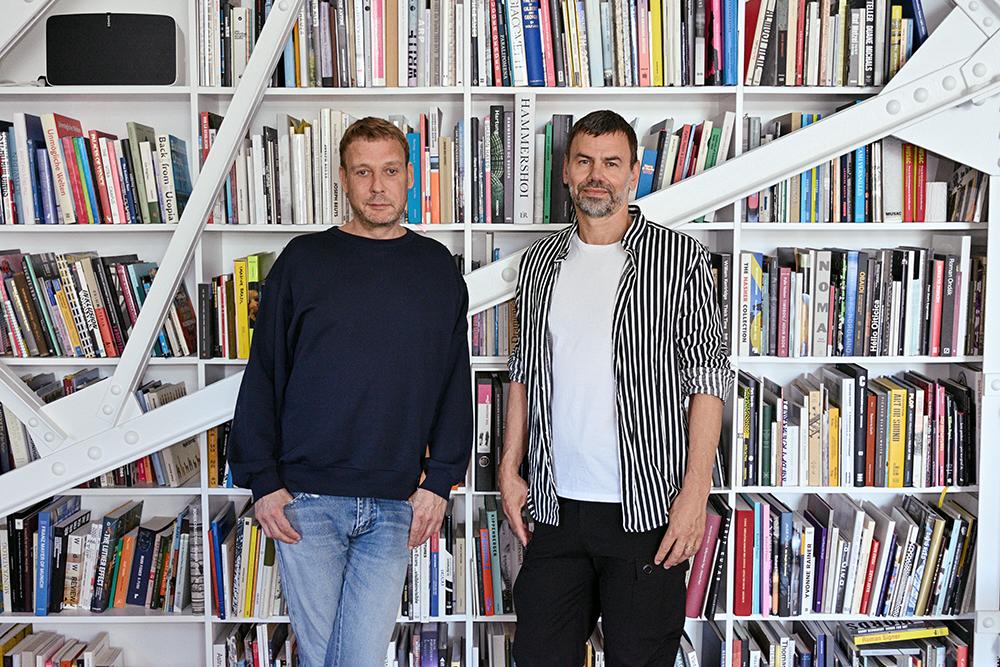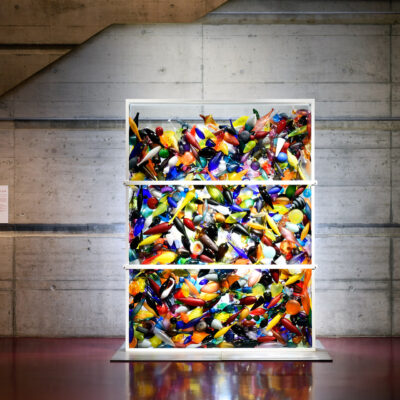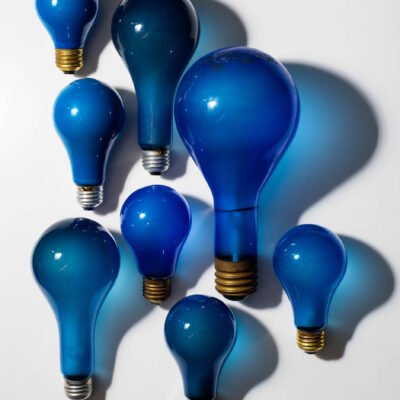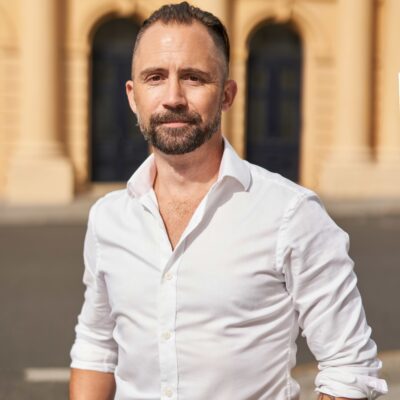Together, Michael Elmgreen and Ingar Dragset make up the art duo Elmgreen & Dragset, whose show Landscapes has just opened at Pace Gallery, Geneva. In their artistic practice, they pursue questions of identity and belonging and investigate social, cultural, and political structures. They are interested in the discourse that can arise if objects are radically re-contextualized, and if normal modes for the representation of art are altered. Often, humour is used to point out absurdities in daily life or modern society. One of their best-known works is the permanent land art structure Prada Marfa, located outside of Valentine, Texas, which was installed in 2005. Using the exact font and colours of the Prada brand, this forever-locked store contrasts with the desert landscape around it and highlights the impractical, materialistic world in which we live. Their show at Pace Gallery addresses the concept of nature and our place in it. Art Vista spoke to Elmgreen & Dragset on the opening of the show about the vastness of the desert, interpreting signs, behaviour patterns, and the cycle of life.

Elmgreen & Dragset , Hard Rain, 2024 patinated bronze
Installation Views, Elmgreen & Dragset: Landscapes,May 23–Aug 10, 2024, Geneva ©Elmgreen & Dragset, courtesy Pace Gallery. Photo: Annik Wetter, courtesy Pace Gallery
Kristen Knupp: I noticed the Wellington boots outside the door when I came in and was wondering if someone left them there due to all the rain we have been having, then I saw the holes cut into the material. I love the sense of humour in your work. Can you tell me about these boots?
Elmgreen & Dragset: When we put on an exhibition, we often like to place an artwork in an unusual context, such as the back room or outside, where people might wonder if it is part of the show or not. These boots have been cast in bronze and have holes in them, so they are doubly impossible to wear. They won’t protect us much if we get caught in a thunderstorm.

Elmgreen & Dragset , The Puzzle. Installation Views, Elmgreen & Dragset: Landscapes,May 23–Aug 10, 2024, Geneva ©Elmgreen & Dragset, courtesy Pace Gallery
Photo: Annik Wetter, courtesy Pace Gallery
KK: They are very realistic sculptures and realism is an important part of your work. In this show there is a boy on the floor doing a puzzle that is amazingly lifelike.
E&M: We work with many different materials. This piece, The Puzzle, is an example of our realistic sculptures made of silicone. It shows a small boy who is trying to put together a puzzle of the sky. The sky is an ongoing theme throughout the exhibition; it is something we all live under, something that is always there but is simultaneously inaccessible and incomprehensible. It is, of course, very difficult to make a puzzle out of something that is so abstract. We have given the boy a difficult task. You could say that he is trying to put together pieces of the works we have in the next room of the gallery.
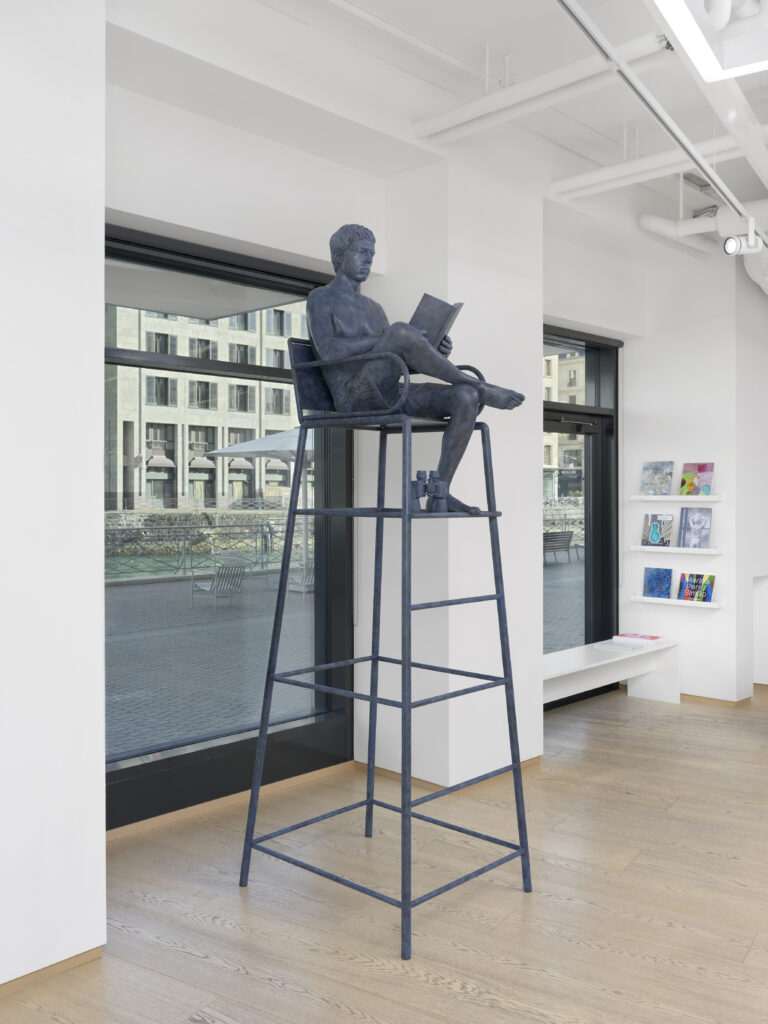
Elmgreen & Dragset, The Guardian, 2023 bronze, lacquer
Installation Views, Elmgreen & Dragset: Landscapes, May 23–Aug 10, 2024, Geneva ©Elmgreen & Dragset, courtesy Pace Gallery. Photo: Annik Wetter, courtesy Pace Gallery
KK: I read that Lac Léman (Lake Geneva) is a site specific parallel to the works in this show – how did it inspire you when curating this exhibition?
Elmgreen & Dragset: We were inspired by the location of Pace next to both the Rhone River and the lake. Here in the gallery, our reading lifeguard (The Guardian), is also in dialogue with the water. He has his binoculars in case something happens, but he is too absorbed in his poetry book to really notice. (He’s maybe a slightly different type of lifeguard than those one sees in Baywatch.)
KK: The Danish poet Inger Christensen famously used the Fibonacci sequence in her poem Alphabet. There is a quote from her on the wall in the gallery which reads: “A desert can be so desolate that nobody knows it exists” How did this poem inspire your work?
E&M: We called the exhibition Landscapes, but it is very much about how we as humans relate to nature. To us, this excerpt from the poem reflects this notion. People in general don’t usually regard themselves as nature, but we are part of it, all of us, somehow. The two of us see the division between urban and natural settings as a bit artificial; the city of Geneva is also nature, in a way.
KK: There is a focus on our connection to the natural world in this exhibition. Is this a departure for you from your previous work which focused more on lookalike places and objects that are re-contextualized, meaning dropping artificial objects like the Prada store into the natural world?
E&M: In some ways yes. But even before this show, we have very often thought about nature as an image or as a concept, as well as what humans project onto nature. Prada Marfa was also dealing with its surroundings as a commodity, and how we are used to seeing such landscapes in western films or advertising, like in Marlboro commercials. So, our associations with nature might be different from what it really is and what it provides. We conceived of Prada Marfa as a remote land art project, but now with TikTok and Instagram, that has all changed and it has become much more accessible. Ultimately, a place becomes the sum of its actual and projected qualities.
This idea plays into our show here as well. The photograph on the back wall is a combination of different photographs. We have put together one large desert using different images. It is not so much about one place, but about the idea of the desert. It is not AI-generated; we are the AI that has generated this image. It is an imaginary desert from our consciousness—our picture of an idealized “nature.”
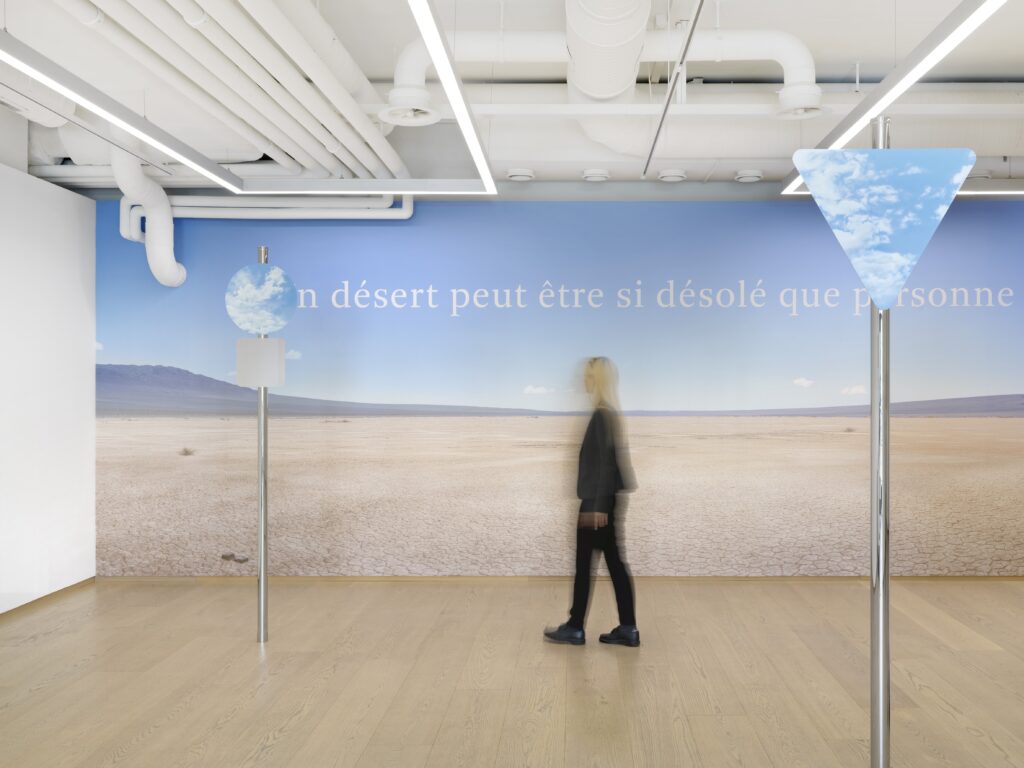
Elmgreen & Dragset, Camouflaged, mirror-polished stainless steel, lacquer
Installation Views, Elmgreen & Dragset: Landscapes, May 23–Aug 10, 2024, Geneva ©Elmgreen & Dragset, courtesy Pace Gallery
Photo: Annik Wetter, courtesy Pace Gallery
KK: How do the signs in the show interact with the poetry on the wall?
E&M: The signs in the exhibition are connected to urban life, and the desert is associated with being lost, with complete openness and with lawlessness. In the desert, you need to find your own way. The street signs, on the other hand, represent the hyper-regulations that one finds in urban settings today. If someone from the 18th century visited our cities, they would probably be puzzled by how we respect street markings, signs, and traffic lights. We follow rules to an extreme and our behaviour patterns are very controlled. The signs in our show have the sky painted on them, an open field that we all share. Before we had signs, people looked to the sky both to find their way and for spiritual guidance, imagining greater forces beyond our physical world.
The mirrored surfaces ask the viewer to make their own judgement, to make up their own minds rather than follow the rules that regulate our behaviour. The signs in the show are actually made to be outside, so we would love to see them become part of the outdoor environment, interacting with the natural world.
KK: With the birds nest that contains a tiny “How to Become a Bird” book, is this piece about identity and belonging, or the feeling of not belonging?
E&M: Our little bird’s nest has a self-help therapy book—even the birds need to read about how to become a bird. Somehow, people were able to parent, to give birth, to become business leaders before all of these self-help books existed. There is a desire to optimize oneself within society; you are constantly led to believe that you are not good enough. Sometimes it is enough to just be. If a bird thought too much about how to be a bird, it wouldn’t be able to fly.
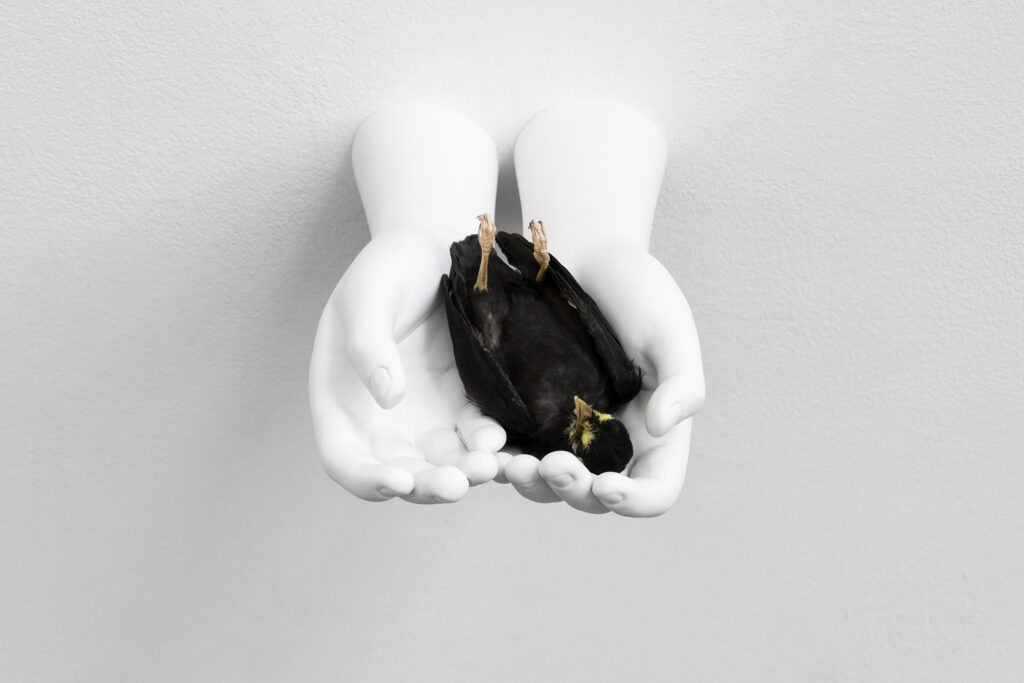
Elmgreen & Dragset, Still Life (Blackbird), 2024, bronze, lacquer, animatronic taxidermy bird, Geneva ©Elmgreen & Dragset, courtesy Pace Gallery, Photo: Annik Wetter, courtesy Pace Gallery.
KK: What were you thinking about when you created the animatronic work with a pair of hands holding a barely breathing blackbird? Is it about the instinct to care for those who are suffering?
E&M: The work hints at these big existential questions, but it is just a simple gesture, someone trying to save this little creature’s life. For many children, the first time they encounter death is when they find an animal struggling. If it is already dead, it is the first time they experience the full cycle of life. This work features an eight-year-old child’s hands, and it’s a bit hopeful, as the chest of the bird is still moving. On a formal level, we wanted to present different materials in this show, and these are white-painted bronze hands with animatronic movement built into the taxidermy bird.
KK: You have been working together since 1995 and you have said previously that the art world prefers that ideas come from a place of lonely inspiration so in that way you don’t fit in. What is it like to work as a duo?
E&M: There is endless disappointment! You come up with an idea that you think is wonderful and the other one says: “No, that won’t work”. It is like when you have a dream and you have a brilliant idea, and then the daylight comes and you realise that it wasn’t that great after all. We are each other’s daylight. We often think about themes, an object, or an article and we talk about it together, editing each other’s thoughts. We don’t clearly divide who does what, so the collaboration involves a lot of dialogue. Every so often, one of our ideas resonates with the other. Maybe then, we suggest giving it a certain twist. It is an organic process.
We didn’t go to an art academy; we met each other in a nightclub. At the time, Ingar was doing theater and Michael was doing poetry. How we ended up in the art world was kind of a coincidence. Hans Ulrich Obrist came to Copenhagen and he selected our work out of a group of portfolios in the Art Council’s presentation of young artists and invited us to do a performance in a show about Nordic Art at the Musée d’Art Moderne in Paris. From there, it all began. It was all coincidental – we were so not professional!

Elmgreen & Dragset Camouflaged, mirror-polished stainless steel, lacquer
Installation Views, Elmgreen & Dragset: Landscapes, May 23–Aug 10, 2024, Geneva ©Elmgreen & Dragset, courtesy Pace Gallery
Photo: Annik Wetter, courtesy Pace Gallery
KK: What is next for you?
E&M: We are working on a big show at the Amorepacific Museum of Art in Seoul, opening on September 2nd of this year. The exhibition is called Spaces and will take up three large exhibition halls in the David Chipperfield-designed museum. We are building a private home in one of the spaces and a pool in another. We’ve explored both of these motifs in earlier exhibitions, but here, the settings will have different artworks and create new narratives. We will also construct a restaurant environment decorated with our own art. We like to transform galleries in order to defy the usual expectation of an exhibition environment. In that way, we hope to see both the audience and our sculptures behave differently.
Elmgreen & Dragset is at Pace Gallery until August 10, 2024.
Cover Portrait of Elmgreen & Dragset: © Elmar Vestner
